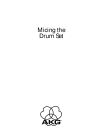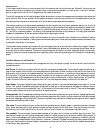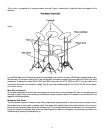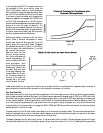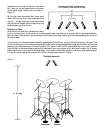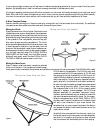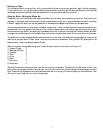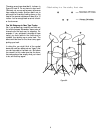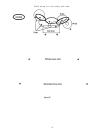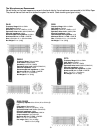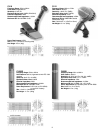
In the old days the AKG D12 dynamic was one of
the mainstays of kick drum micing; today, the
D112 is the modern version of that microphone.
With its carefully engineered bass resonance cham-
ber the D112 can handle any kick drum with ease.
If you want to use a condenser with ultrawide low
frequency capability, we suggest the C4000B, with
its 0.5% THD overload point of 145 dB. Figure 2
shows the difference between a dynamic and a con-
denser at or near the onset of distortion. The
dynamic has more residual distortion than the con-
denser, but the condenser goes into gross distortion
at a point where the dynamic may still be produc-
ing only moderate amounts of distortion.
Another big decision is where to put the micro-
phone. Since a cardioid microphone is nearly
always used, there will be a good bit of low fre-
quency boost due to proximity effect. Suggested
mic positions are shown in Figure 3. If the micro-
phone is close to the middle (position 1), you will
get a sound that has per-
haps too much low end
and not enough articula-
tion. As the microphone is
moved progressively off-
center, the sound will have
more articulation, since
you will be picking up less
fundamental sound from
the head. Stop well short
of the edge, keeping a dis-
tance of about 4 to 5 inch-
es. The actual distance of
the mic to the head will
normally be in the range
from 5 to about 2 inches.
Under some conditions, you may find it useful to put up a second kick mic, recording both on separate tracks, of course. A
good combination here would be a dynamic on one track and a condenser on the other.
The Overhead Pair:
Pick these mics carefully, since they provide the largest part of the sonic stage you are looking for. Studio engineers usually
pick the best condenser cardioids they have. For the most natural response we suggest a pair of C391’s or C480’s with their
ultralinear high frequency response. If you want a slightly brighter sound, use a pair of AKG large diaphragm condensers set
in their cardioid position. Another good choice is the C1000S. Its included presence booster creates a frequency rise in the
5 to 9 kHz range that guarantees you’ll get a sound that will cut gently through a complex mix, even when the drummer
is playing softly. For the home studio or on-stage the D440, D550 and D660 are excellent alternatives, with their broad high
frequency boost in the 8 kHz range.
The best position for the OH pair is often found about 6 to 8 inches over the player’s head. The mics should always be car-
dioids or hypercardioids in order to hold down studio leakage, and should be pointed outward from each other and down
toward the hi-hat on the left side and the large tom on the right side.
The spacing between the OH pair is fairly critical. If they are close (within one foot), the sound stage you get will be tight
with good delineation but with limited stereo spread. As you move the mics from 1 to 2 to 3 (keeping their target aiming
4
Figure 2
Figure 3



